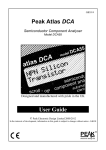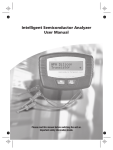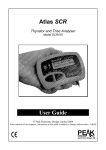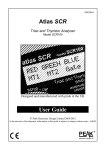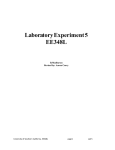Download The Peak Atlas User Guide
Transcript
The Peak Atlas Component Analyser User Guide Peak Electronic Design Limited is committed to continued product development and improvement. The information and specifications contained within this user guide may therefore be subject to change. Copyright Peak Electronic Design Limited 2000 Peak Atlas User Guide July 2001, Rev. 5 Section Page Introduction .............................................................................. 3 Analysing components ............................................................. 4 Diodes ................................................................................ 5 Diode Networks ................................................................. 6 LEDs (including Bicolour LEDs)...................................... 7 Bipolar Junction Transistors (BJTs) .................................. 8 Enhancement Mode MOSFETs....................................... 11 Depletion Mode MOSFETs............................................. 12 Junction FETs .................................................................. 13 Thyristors (SCRs) and Triacs .......................................... 14 Care of your Atlas................................................................... 15 Technical Specifications......................................................... 16 Page 2 ENGLISH Contents Peak Atlas User Guide July 2001, Rev. 5 The Peak Atlas is a new generation of intelligent component analyser that offers unrivalled functionality together with refreshing simplicity. The Atlas brings a world of component data to your fingertips. Features • • • • • • • • Automatic component identification. Bipolar transistors Darlington transistors Enhancement Mode MOSFETs Depletion Mode MOSFETs Junction FETs Triacs Thyristors LEDs Bicolour LEDs Diodes Diode networks Automatic pinout identification for all the above component types. Special feature identification such as diode protection and resistor shunts. Gain measurement for transistors. Gate threshold measurement for Enhancement Mode MOSFETs. Semiconductor forward voltage measure ments for diodes, LEDs and transistors. Semiconductor test current measurement. Automatic and manual power-off. The Peak Atlas is optimised to accurately analyse the vast majority of supported component types. However, it is not possible to support every component due to the wide range of required operating conditions, as such, displayed information should be interpreted accordingly. Specification limits and specific analysis capabilities are detailed in this guide. WARNING Under no circumstances must the Atlas be connected to any powered devices as this may cause damage to both the Atlas and the device under test. Additionally, the Atlas is not rated for high voltage use and personal injury or death may result from inappropriate use. Please note also that energy stored in external equipment’s capacitors may be sufficient to cause irreparable damage to the Atlas. Analysis of discrete, unconnected components is recommended. Page 3 ENGLISH Introduction Peak Atlas User Guide July 2001, Rev. 5 The Peak Atlas is designed to analyse discrete, unconnected, unpowered components. This ensures that external connections don’t influence the measured parameters. The three test probes can be connected to the component any way round. If the component has only two terminals, then any pair of the three test probes can be used. The Peak Atlas will start component analysis when the on/test button is pressed if the unit is powered down. If the Atlas is not powered down then a new analysis can be started by pressing and The Peak Atlas holding the scroll/off button first to power down is analysing.... the unit and then pressing the on/test button. Depending on the component type, analysis may take a few seconds to complete, after which, the results of the analysis are displayed. Information is displayed a “page” at a time, each page can be displayed by pressing the scroll/off button. The arrow symbol on the display indicates that more pages are available to be viewed. If the Atlas cannot detect any component between any of the test probes, the following message will be displayed: No component detected If the component is not a supported component type, a faulty component or a component that is being tested in-circuit, the analysis may result in the following message being displayed: Unknown/Faulty component It is possible that the Atlas may detect one or more diode junctions or other component type within an unknown or faulty part. This is because many semiconductors comprise of pn (diode) junctions. Please refer to the section on diodes and diode networks for more information. Page 4 ENGLISH Analysing Components Peak Atlas User Guide July 2001, Rev. 5 The Atlas will analyse almost any type of diode. Any pair of the three test clips can be connected to the diode, anyway round. If the Atlas detects a single diode, the following message will be displayed. Pressing the scroll/off button will then display the pinout for the diode. In this example, the Anode of the diode is connected to the Red test clip and the Cathode is connected to the Green test clip, additionally, the Blue test clip is unconnected. The forward voltage drop is then displayed, this gives an indication of the diode technology. In this example, it is likely that the diode is a silicon diode. A germanium or Schottky diode may yield a forward voltage of about 0.25V. The current at which the diode was tested is also displayed. Diode or diode junction(s) RED GREEN BLUE Anod Cath Forward voltage Vf=0.67V Test current If=4.62mA Note that the Atlas will detect only one diode even if two diodes are connected in series when the third test clip is not connected to the junction between the diodes. The forward voltage drop displayed however will be the voltage across the whole series combination. The Atlas will determine that the diode(s) under test is an LED if the measured forward voltage drop exceeds 1.50V. Please refer to the section on LED analysis for more information. Zener diodes are not directly supported by the Atlas. Zener diodes with breakdown voltages of approximately 5V or higher however, will be detected as a single diode. Page 5 ENGLISH Diodes Peak Atlas User Guide July 2001, Rev. 5 The Atlas will intelligently identify popular types of three terminal diode networks. For three terminal devices such as SOT-23 diode networks, the three test clips must all be connected, anyway round. The Atlas will identify the type of diode network and then display information regarding each detected diode in sequence. The following types of diode networks are automatically recognised by the Atlas: Common cathode diode network Two-diode device with both cathodes connected together, such as the Philips SOT-23 BAV70. Common anode diode network Two-diode device with both anodes connected together, such as the Philips SOT-323 BAW56W. Series diode network Two-diode device with each diode connected in series. The Philips SOT-23 BAV99 is a popular type of series diode network. Following the component identification page, the Atlas will display details of each detected diode within the diode network. Firstly, the pinout for the diode is displayed, followed by the electrical information, forward voltage drop and the current at which the diode was tested. The value of the test current depends on the measured forward voltage drop of the diode. Following the display of all the details for the first diode, the details of the second diode will then be displayed. Page 6 Pinout for D1... RED GREEN BLUE Anod Cath Forward voltage D1 Vf=0.67V Test current D1 If=4.62mA ENGLISH Diode Networks Peak Atlas User Guide July 2001, Rev. 5 An LED is really just a another type of diode, LED or diode however, the Atlas will determine that an LED or LED network has been detected if the measured junction(s) forward voltage drop is larger than 1.5V. This also enables the Atlas to intelligently identify bicolour LEDs, both two-terminal and threeterminal varieties. RED GREEN BLUE Cath Anod Like the diode analysis, the pinout, the forward voltage drop and the associated test current is displayed. Forward voltage Vf=1.92V Here, the Cathode (-ve) LED terminal is connected to the Green test clip and the Anode (+ve) LED terminal is connected to the Blue test clip. Test current If=3.28mA In this example, a simple green LED yields a forward voltage drop of 1.92V at the test current of 3.28mA. The test current depends on the forward voltage. Bicolour LEDs Bicolour LEDs are automatically identified. A Two terminal two terminal bicolour LED consists of two LED chips which are connected in inverse parallel bicolour LED within the LED body. Three terminal bicolour LEDs are made with either common anodes or common cathodes. The pinouts and the electrical Three terminal characteristics are displayed in the same way as bicolour LED the diode networks analysis. The details of each LED chip are individually displayed. Interestingly, this allows for the pinouts relating to the different colours within the bicolour LED to be determined. This is because, different colour LEDs exhibit different forward voltage drops. Red LEDs often have the lowest forward voltage drop, followed by yellow LEDs, green LEDs and finally, blue LEDs. Some blue LEDs (and their cousins, white phosphor LEDs) require high forward voltages and may not be detected by the Atlas. Page 7 ENGLISH LEDs (including bicolour LEDs) Peak Atlas User Guide July 2001, Rev. 5 Bipolar Junction Transistors (BJTs) ENGLISH Bipolar Junction Transistors are simply “conventional” transistors, although variants of these do exist such as Darlingtons, diode protected, resistor shunted types and combinations of these types. All of these variations are automatically identified by the Atlas. Bipolar Junction Transistors are available in two main types, NPN and PNP. In this example, the Atlas has detected an PNP transistor. PNP bipolar transistor If an NPN Darlington transistor was detected for example, the following message would be displayed: NPN bipolar Darlington Please note that the Atlas will determine that the transistor under test is a Darlington type if the base-emitter voltage drop is greater than 1.00V for devices with a base-emitter shunt resistance of greater than 60kΩ or if the base-emitter voltage drop is greater than 0.80V for devices with a base-emitter shunt resistance of less than 60kΩ. The measured base-emitter voltage drop is displayed as detailed later in this section. Pressing the scroll/off button will result in the transistor’s pinout being displayed. Here, the Atlas has identified that the Base is connected to the Red test clip, the Collector is connected to the Green test clip and the Emitter is connected to the Blue test clip. RED GREEN BLUE Base Coll Emit C Faulty or Very Low Gain Transistors B Faulty transistors that exhibit no or very low gain may cause the Atlas to only identify one or more diode junctions within the E device. This is because NPN transistors consist of a structure of junctions that behave like a common anode diode network. PNP transistors can appear to be common cathode diode networks. The common junction Common anode represents the base terminal. This is normal for diode network situations where the current gain is so low that it is immeasurable at the test currents used by the Atlas. Page 8 Peak Atlas User Guide July 2001, Rev. 5 Many modern transistors contain additional special features. If the Atlas has detected any special features, then the details of these features are displayed next after pressing the scroll/off button. Some transistors, particularly CRT Diode protection deflection transistors and many large Darlingtons have a between C-E protection diode inside their package connected between the collector and emitter. The Philips BU505DF is a typical example of a diode protected bipolar transistor. Remember that protection diodes are always internally connected between the collector and the emitter so that they are normally reverse biased. For NPN transistors, the anode of the diode is connected to the emitter of the transistor. For PNP transistors, the anode of the diode is connected to the collector of the transistor. Additionally, many Darlingtons and a few conventional transistors also have a resistor shunt network between the base and emitter of the device. The Atlas can detect the resistor shunt if it has a resistance of typically less than 60kΩ. The popular Motorola TIP110 Darlington transistor contains internal resistors between the base and emitter. Resistor shunt between B-E HFE not accurate due to B-E res It is important to note that if a transistor does contain a base-emitter shunt resistor network, any measurements of current gain (HFE) will be very low at the test currents used by the Atlas. This is due to the resistors providing an additional path for the base current. The readings for gain however can still be used for comparing transistors of a similar type for the purposes of matching or gain band selecting. The Atlas will warn you if such a condition arises as illustrated above. Page 9 ENGLISH Transistor Special Features Peak Atlas User Guide July 2001, Rev. 5 Current gain HFE=126 The DC current gain (HFE) is displayed after any special transistor features that may have been displayed. DC current gain is simply the ratio of the collector current to the base current for a particular operating condition. The Atlas measures HFE at a collector current of 2.50mA and a collector-emitter voltage of between 2V and 3V. The gain of all transistors can vary considerably with collector current, collector voltage and also temperature. The displayed value for gain therefore may not represent the gain experienced at other collector currents and voltages. This is particularly true for large devices. Test current Ic=2.50mA Darlington transistors can have very high gain values and more variation of gain will be evident as a result of this. Additionally, it is quite normal for transistors of the same type to have a wide range of gain values. For this reason, transistor circuits are often designed so that their operation has little dependence on the absolute value of current gain. The displayed value of gain is very useful however for comparing transistors of a similar type for the purposes of gain matching or fault finding. Base-Emitter Voltage Drop Finally, the DC characteristics of the base-emitter junction are displayed, both the base-emitter forward voltage drop and the base current used for the measurement. B-E voltage Vbe=0.77V The forward base-emitter voltage drop can aid in Test current the identification of silicon or germanium devices. Germanium devices can have base-emitter voltages Ib=4.52mA as low as 0.2V, Silicon types exhibit readings of about 0.7V and Darlington transistors can exhibit readings of about 1.2V because of the multiple base-emitter junctions being measured. Note that the Atlas does not perform the base-emitter tests at the same base current as that used for the current gain measurement. Page 10 ENGLISH Current Gain (HFE) Peak Atlas User Guide July 2001, Rev. 5 MOSFET stands for Metal Oxide Semiconductor Field Effect Transistor. Like bipolar transistors, MOSFETs are available in two main types, NChannel and P-Channel. Most modern MOSFETs are of the Enhancement Mode type, meaning that the bias of the gate-source voltage is always positive (For N-Channel types). The other (rarer) type of MOSFET is the Depletion Mode type which is described in a later section. MOSFETs of all types are sometimes known as IGFETs, meaning Insulated Gate Field Effect Transistor. This term describes a key feature of these devices, an insulated gate region that results in negligible gate current for both positive and negative gate-source voltages (up to the Enhancement mode maximum allowed values of course, typically N-Ch MOSFET ±20V). The first screen to be displayed gives information on the type of MOSFET detected. Pressing scroll/off will then result in the pinout of the MOSFET being displayed. The gate, source and drain are each identified. An important feature of a MOSFET is the gatesource threshold voltage, the gate-source voltage at which conduction between the source and drain starts. The gate threshold is displayed following the pinout information. The Atlas detects that drain-source conduction has started when it reaches 2.50mA. This condition is confirmed by the next displayed page. RED GREEN BLUE Gate Drn Srce Gate Threshold Vgs=3.47V Test current Id=2.50mA All Enhancement Mode MOSFETs contain a protection diode junction between the source and drain terminals. If the Atlas does not detect this diode the device will be rejected as an Enhancement Mode MOSFET. Page 11 ENGLISH Enhancement mode MOSFETs Peak Atlas User Guide July 2001, Rev. 5 The rare Depletion Mode MOSFET is very similar to the conventional Junction FET (JFET) except that the gate terminal is insulated from the other two terminals. The input resistance of these devices can typically be greater than 1000MΩ for negative and positive gate-source voltages. Depletion Mode devices are characterised by the gate-source voltage required to control the drainsource current. Modern Depletion Mode devices are generally only available in N-Channel varieties and will conduct current between it’s drain and source terminals even with a zero voltage applied across the gate and the source. The device can only be turned completely off by taking it’s gate significantly more negative than it’s source terminal, say –10V. It is this characteristic that makes them so similar to conventional JFETs. Depletion mode N-Ch MOSFET Pressing scroll/off will cause the pinout screen to be displayed. Page 12 RED GREEN BLUE Drn Gate Srce ENGLISH Depletion Mode MOSFETs Peak Atlas User Guide July 2001, Rev. 5 Junction FETs are conventional Field Effect Transistors. The voltage applied across the gate-source terminals controls current between the drain and source terminals. N-Channel JFETs require a negative voltage on their gate with respect to their source, the more negative the voltage, the less current can flow between the drain and source. Unlike Depletion Mode MOSFETs, JFETs have no insulation layer on the gate. This means that although the input resistance between the gate and source is normally extremely high (greater than 100MΩ), the gate current can rise if the semiconductor junction between the gate and source or between the gate and drain become forward biased. This can happen if the gate voltage becomes about 0.6V higher than either the drain or source terminals for NChannel devices or 0.6V lower than the drain or source for P-Channel devices. The internal structure of JFETs is essentially symmetrical about the gate terminal, this means that the drain and source terminals are indistinguishable by the Atlas. The JFET type and the gate terminal are identified however. Drain and Source not identified P-Channel Junction FET RED GREEN BLUE Gate Page 13 ENGLISH Junction FETs (JFETs) Peak Atlas User Guide July 2001, Rev. 5 Sensitive low power thyristors (Silicon Controlled Rectifiers - SCRs) and triacs can be easily identified and analysed with the Atlas. Triac operation is very similar to that of thyristors, although the Atlas is able to distinguish between them. Sensitive Thyristor terminals are the anode, cathode and the gate. The pinout of the thyristor under test will be displayed on the next press of the scroll/off button. Sensitive or low power triac RED GREEN BLUE MT1 MT2 Gate or low power thyristor RED GREEN BLUE Gate Anod Cath Triac terminal nomenclature is less universal than most components although many manufacturers are standardising on the terms gate, MT1 and MT2, (MT standing for main terminal). To avoid ambiguity, MT1 is the terminal with which gate current is referenced. That is, gate current is injected or extracted from the gate-MT1 junction. The Atlas determines that the device under test is a triac by checking the gate trigger quadrants that the device will reliably operate in. Thyristors operate in only one quadrant (positive gate current, positive anode current). Triacs can typically operate in three or four quadrants, hence their use in AC control applications. The test currents used by the Atlas are kept low (<5mA) to eliminate the possibility of damage to a vast range of component types. Some thyristors and triacs will not operate at low currents and these types cannot be analysed with this instrument. Note also that if only one trigger quadrant of a triac is detected then the Atlas will conclude that it has found a thyristor. Please see the technical specifications for more details. Page 14 ENGLISH Thyristors (SCRs) and Triacs Peak Atlas User Guide July 2001, Rev. 5 The Peak Atlas should provide many years of service if used in accordance with this user guide. Care should be taken not to expose your unit to excessive heat, shock or moisture. Additionally, the battery should be replaced at least every 12 months to reduce the risk of leak damage. If a low battery warning message appears, immediate replacement of the battery is recommended as measured parameters may be affected. The Atlas will however continue to operate. * Low Battery * The battery can be replaced by carefully opening the Atlas by removing the three screws from the rear of the unit. Take care not to damage the electronics. The battery should only be replaced with a high quality battery identical to, or equivalent to an Alkaline GP23A or MN21 12V (10mm diameter x 28mm length). Replacement batteries are available directly from Peak Electronic Design Limited. Self Test Procedure Each time the Atlas is powered up, a self test procedure is performed. In addition to a battery voltage test, the Atlas measures the performance of many internal functions such as the voltage and current sources, amplifiers, analogue to digital converters and test lead multiplexers. If any Self test failed of these function measurements fall outside tight performance limits, a message will be displayed CODE: 5 and the Atlas will switch off automatically. If the problem was caused by a temporary condition on the test clips, such as applying power to the test clips, then simply re-starting the Atlas may clear the problem. If a persistent problem does arise, it is likely that damage has been caused by an external event such as excessive power being applied to the test clips or a large static discharge taking place. If the problem persists, please contact us for further advice, quoting the displayed fault code. If there is a low battery condition, the automatic self test procedure will not be performed. Page 15 ENGLISH Care of your Atlas Peak Atlas User Guide July 2001, Rev. 5 Technical Specifications Parameter Peak test current into S/C Peak test voltage across O/C Measurable transistor gain range (HFE) Transistor gain accuracy Transistor VCEO Transistor VBE accuracy VBE for Darlington identification VBE for Darlington identification (shunted) Acceptable transistor VBE Base-emitter shunt resistance threshold Transistor collector-emitter test current Acceptable transistor collector leakage EM MOSFET gate threshold range EM MOSFET gate threshold accuracy EM MOSFET drain-source test current EM MOSFET minimum gate resistance DM MOSFET drain-source test current JFET drain-source test current Thyristor/Triac gate test current Thyristor/Triac load test current Diode test current Diode forward voltage accuracy VF for LED identification Battery type Battery voltage range Battery voltage warning threshold Inactivity power-down period Dimensions (excluding test leads) Operating temperature range 1. 2. 3. 4. 5. 6. 7. 8. 9. Minimum -5.5mA -5.1V 4 Typical Maximum 5.5mA 5.1V 65000 ±3% ±5 HFE 2.0V -2%-20mV 3.0V +2%+20mV 1.0V 0.8V Note 1 1 2 2,9 2 9 3 4 1.80V 2.45mA 0.1V -2%-20mV 2.45mA 60kΩ 2.50mA 0.7mA 2.50mA 8kΩ 0.5mA 0.5mA 2.55mA 5.0V +2%+20mV 2.55mA 6 5 5 5.5mA 5.5mA 4.5mA 5.0mA 5.0mA -2%-20mV +2%+20mV 1.50V GP23A 12V Alkaline 7.50V 12V 8.25V 30 secs (5 secs for single screen results) 103 x 70 x 20 mm 0°C 50°C 7 8 Between any pair of test clips. Collector current of 2.50mA. Gain accuracy valid for gains less than 2000. Resistance across reverse biased base-emitter > 60kΩ. Resistance across reverse biased base-emitter < 60kΩ. Drain-source current of 2.50mA. Collector-emitter voltage of 5.0V. Thyristor quadrant I, Triac quadrants I and III. Subject to acceptable LCD visibility. BJT with no shunt resistors. Designed and made in England by Peak Electronic Design Limited Alas House, Kiln Lane, Harpur Hill Industrial Estate, Buxton, Derbyshire, SK17 9JL, England. Web: www.peakelec.co.uk Email: [email protected] Telephone. +44 (0) 1298 70012 Fax: +44 (0) 1298 70046 Page 16 ENGLISH All values are at 25°C unless otherwise specified.
















